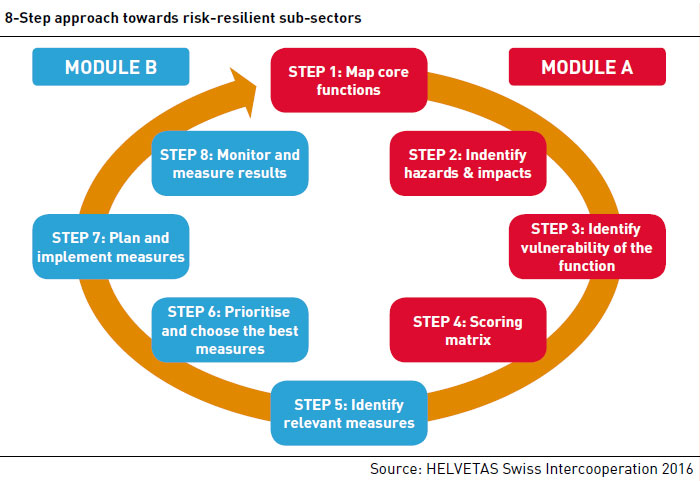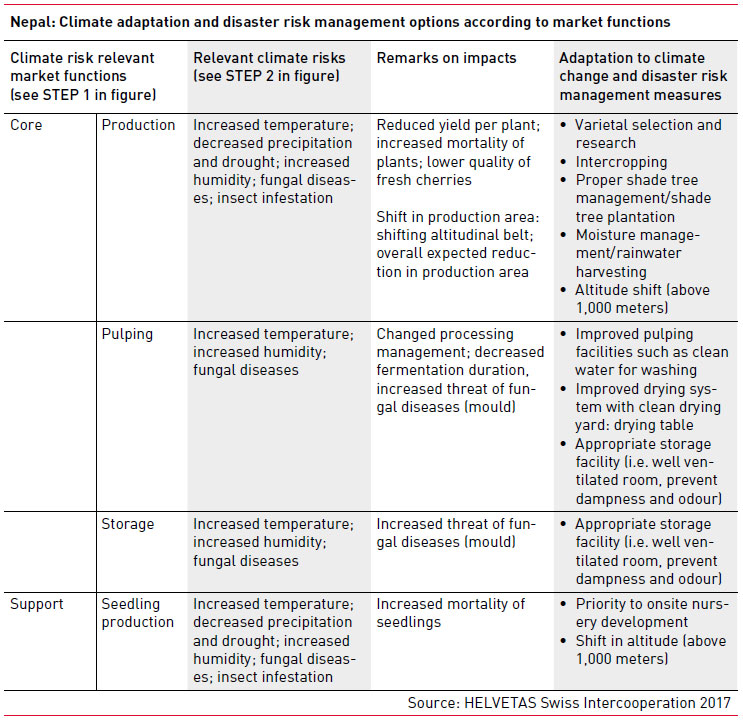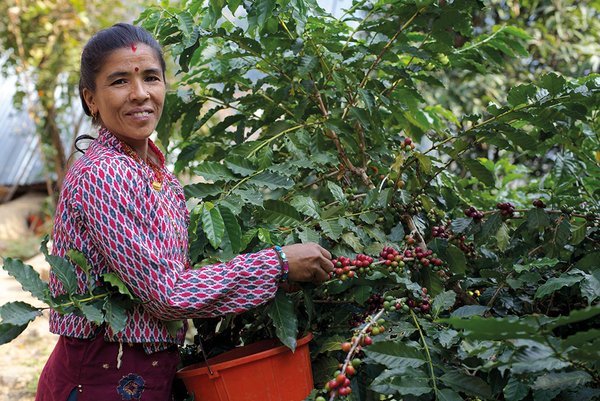 Download this article in magazine layout
Download this article in magazine layout
- Share this article
- Subscribe to our newsletter
How to consider climate risks in market systems
Already today, climate change, in the form of extreme events, seasonal variability with too much rain or lack of rainfall combined with high temperature, is a harsh reality for millions of farmers who have to cope with degraded and weakened natural resource systems. They often lack knowledge about potential options for adapting their production systems and have limited assets and risk-taking capacity to access and use technologies and financial services. However, opportunities are also emerging where farmers can suddenly grow crops that they could not grow in the past. It is therefore important to apply a climate risk and vulnerability approach in natural resource-based market systems and hence take proactive and planned rather than reactive action, including identifying emerging opportunities.
For this reason, Helvetas Swiss Intercooperation started to systematically address climate risks in its market system projects and has recently developed the Guideline “Assessing Climate Risks and Vulnerabilities in Market Systems” (see Box below). The Guideline shall help (small-scale) businesses, private and public, in better understanding climate risks and opportunities in their sub-sector, identifying where emerging market opportunities exist and developing a comprehensive climate risk management approach as part of the enterprise. To maintain a viable sub-sector, all market actors have to understand the importance of including climate adaptation and disaster risk management in the perceived or foreseen changes in their sphere of influence and responsibility. The proposed measures should be environmentally, socially and economically sound in order to justify the investments of different market actors.
THE GUIDELINE IN A NUTSHELL
The Guideline “Assessing Climate Risks and Vulnerabilities in Market Systems” builds on existing
approaches (i.e. risk assessment tools such as the Community-based Risk Screening
Tool, Adaptation & Livelihoods – CRiSTAL or the Climate, Environment Disaster Risk Integration
Guidance – CEDRIG (see page 22)) as well as approaches related to market systems development.
It seeks to orientate and support practitioners by bringing in a risk and vulnerability
perspective in market systems and identifying the most climate-resilient sub-sectors in a given
context. It consists of a series of eight steps, structured according to Module A and Module B.
Module A launches an analysis of the wider and broader market system that contains the
core functions of a system (Step 1). This is then followed by a detailed risk assessment of
current and potential hazards (Step 2). Step 3 involves an analysis of the different functions
and their vulnerability to current and potential climate risks. And finally, the most resilient
sub-sectors to climate change are identified based on a scoring matrix in Step 4. With the
support of Module B, the most appropriate measures for adapting to climate change and
managing disaster risks for a specific sub-sector are identified (Step 5), resulting in a concrete
action plan (sustainability matrix) where role and responsibility for short- and longterm
measures are defined (Step 7). And finally, Step 8 supports practitioners in elaborating
result chains for monitoring and measuring the results.
Currently, the Guideline has been applied by Helvetas in various sub-sectors in Nepal (coffee, banana, sweet organs, walnuts, macadamia, medicinal and aromatic plants, riverbed vegetables and charcoal) and Madagascar (cacao and cotton jointly with Lima bean and Artemisia annua). In the following section, we share some results.
Shifting coffee cultivation boundaries in Nepal
The Asian Highland region has been warming at greater than global average rates, and projections indicate continuing increases in temperatures by two to four degrees Celsius into the 2050s. Despite much regional variation and uncertainty regarding rising temperatures and associated changes in precipitation and evaporation, these climatic changes will lead to shifts in production areas and hence to changes in agricultural practice among small-scale farmers. According to the risk assessment conducted with three different stakeholder groups (members of a coffee co-operative, representatives of a district coffee cooperative union and the coffee promotion team of Helvetas) and complemented with scientific information, coffee production is adversely affected by rising temperatures linked with increasing humidity and a decrease in precipitation as well as increased occurrence of fungal diseases and insect infestations and increased drought during the dry season due to a decrease in precipitation in that season. The results of the risk assessment are in line with farmers’ observations reporting decreasing quality of green bean caused by higher temperatures and humidity at lower altitudes.
The analysis further revealed that not only the production but also other core and support functions such as pulping, storage and seedling production are affected by climate risks. Based on the main impacts identified for each market function, possible adaptation and disaster risk management options were identified (see Table). For the final measures selected, jointly with stakeholders, an Action Plan (sustainability matrix) has been developed defining each actor’s role in the system, i.e. who will do it (implementation responsibility) and who will pay for it (financial responsibility). The Action Plan reflects a good mixture of short-term and longer-term measures which require more incremental and transformative changes such as varietal research or a shift to higher altitude, implying that coffee production below 1,000 metres above sea level may no longer be appropriate in Nepal.

Short-term measures such as intercropping, promotion of proper shade trees as well as moisture management were also identified. Based on these proposals, different actors have initiated the implementation of concrete measures and facilitated further discussions to prepare the farmers to these changing climatic conditions and hence to become more climate-resilient.
Interestingly enough, the findings from Nepal are in line with a recent study conducted on coffee production in Latin America where even under an intermediate emission scenario (the so-called RCP or Representative Concentration Pathway, 4.5), the total for suitable land for coffee production is expected to fall by 73 per cent by 2050 compared to 1950–2010.
A relatively resilient cocoa sub-sector in Madagascar
Cocoa dominates the area around the Sambirano River in northwest Madagascar, delivering weekly incomes for more than 30,000 farmers. The region is characterised by a microclimate ideal for cocoa with hardly any chemical additives that is purchased by well-known chocolatiers. However, despite the area under cultivation having almost doubled during the last decade, yield has dropped, one of the reasons for this being climate change. Helvetas has applied the Guideline in its cocoa project, which is funded by the Lindt Cocoa Foundation as part of the Lindt & Sprüngli Farming Program.
The application of the Guideline, which included focus group discussions with farmers and interviews with state and private actors, complemented by secondary data, revealed that the changing of seasons (i.e. longer dry seasons and shorter rainy seasons, with both more accentuated) is regarded as a major hazard. Not only has it already had an impact, but it will further exacerbate other prioritised hazards such as flooding, cyclones, droughts, fungal diseases and insects. The application has shown that these hydro-meteorological phenomena affect not only production but also other core functions within the market system such as drying and transport. The continuing trend of increasing mean and maximum temperatures could significantly enhance future drought stress and hence become a limiting production factor. Since the introduction of cocoa as a cash crop, the increased groundwater level has been one of the reasons why cocoa plants in the region endure a dry season that exceeds by far the tolerance level of three months with less than 100 mm rainfall.
Alongside the Helvetas interventions which already contribute to climate resilience (e.g. sharing knowledge of biological treatment of recently emerged pests in the training modules, introduction of rain-resistant drying infrastructure), adaptation and disaster risk management measures are included in the training modules for cocoa producers to enhance the farmers’ climate adaptation capacity and raise their awareness concerning ecosystem services of forests and natural resources. While Helvetas supports the development and realisation of these training modules, trainers of local partners (i.e. operators/exporters and supporting institutions) carry them out.
The application of the Guideline resulted in the discovery of mutual influences between climate risks and unexploited potentials of market systems that can now be addressed in a more comprehensive manner. For example, reforestation of hills or systematic shade tree management decrease future climate risks and can be combined with strategies of integrated pest management, alternative incomes based on timber or non-timber products or the valorisation of carbon storage in compensation projects. Other identified measures are related to local weather stations and warning systems, sewerage, phyto-sanitary studies, weather and pest-resilient stocking methods, research on climate-resilient cocoa varieties and shade trees.
Climate change is the greatest and widest-ranging market failure ever seen, as in most markets, the effect of this market dysfunction falls most on those least able to take action to escape its consequences
The Stern Report
In sum, while climate does affect the different functions of the cocoa system, the analysis revealed that cocoa is still more climate resilient compared to other local products, i.e. rice that is mainly cultivated in subsistence. Even though far from replacing the functions of primary forests, cocoa in agroforestry can also serve as an important climate regulator. The application facilitated the findings of combining adaptation, mitigation and development goals. Such a comprehensive multi-benefit approach is key for sustainable development and in line with current initiatives on sustainable cocoa.
Adjustable to local contexts
The application of the Guideline confirms that a sound understanding of the causes and effects of climate change is required to facilitate long-term viability of agricultural sub-sectors and to identify innovative and efficient adaptation and risk management solutions. Risk and vulnerability assessments are the first crucial steps towards a better understanding of the local context. In the case of Nepal, where various sub-sectors have been assessed, climate impacts vary from sub-sector to sub-sector within the same region. This confirms once more that there is no one size fits all approach when it comes to adaptation to climate change, and hence sound risk assessment is key to identifying future interventions. And it underlines the importance of carefully monitoring adaptation measures in order to see what works and what does not and hence to make necessary adjustments (adaptive learning). This also gives space for identifying good practices and measures that are suitable for scaling up new measures or assessing whether new strategies need to be included. Different actors have different stakes in the market system, but rely on each other’s performance. This requires all the actors to review their role, their possible contributions and their necessary actions towards concentrated efforts to climate change adaptation and risk management.
Here, the Guideline can make an important contribution. Experience so far has demonstrated that it represents an effective, simple and low-cost instrument for single use and/or comparative purposes (i.e. same sub-sectors in different regions, different sub-sectors in the same region). Practitioners can apply and adjust it to their local contexts and needs; and it can help them approach development issues systematically and balance economic, social, political and ecological demands in a sustainable way.
Nicole Clot is Senior Advisor Adaptation to Climate Change at HELVETAS Swiss Intercooperation.
Contact: nicole.clot@helvetas.org
(With inputs from Jürg Merz, Andrea Wynistorf, Lea Eymann and Annick Vollmar)
References and further reading
Guideline
https://www.helvetas.org/guideline_cc_ms
Study on coffee plantations in Latin America
www.carbonbrief.org/coffee-faces-dual-threat-farmland-loss-bee-decline-warmer-climate
Further reading on cocoa production
http://www.worldcocoafoundation.org/cocoa-forests-initiative/
Risk Assessment tools
IISD, IUCN, SEI, Intercooperation (2012). CRiSTAL - Community-based Risk Screening Tool,
Adaptation and Livelihoods. http://www.iisd.org/cristaltool/
Swiss Agency for Development and Cooperation (2015). CEDRIG - The Climate, Environment
and Disaster Risk Reduction Integration Guideline. www.cedrig.org
CEDRIG light:
https://www.cedrig.org/sites/default/themes/cedrig/img/CEDRIG_Light_EN.pdf
CEDRIG strategic:
https://www.cedrig.org/sites/default/themes/cedrig/img/CEDRIG_Strategic_EN.pdf
CEDRIG operational:
https://www.cedrig.org/sites/default/themes/cedrig/img/CEDRIG_Operational_EN.pdf
CEDRIG handbook (2012):
www.shareweb.ch/site/Disaster-Resilience/Tools-Training/Documents/52_CEDRIG_Part_
II_Handbook_EN_Print.pdf
Barrueto, Andrea Karin; Merz, Juerg; Clot, Nicole; Hammer, Thomas (2017): Climate changes and their impact on agricultural market systems: examples from Nepal. In: Sustainability (2017), 9, 2207; doi:10.3390/su9122207
Grumbine Robert Edward, Dr Arjumand Nizami, Bikram Rana Tharu, Rabin Niraula, Yufang Su, Dr Jianchu Xu Water Governance in the Asian Highlands. Working Paper 198. World Agroforestry Centre 2015
Hijioka, Y., E. Lin, J.J. Pereira, et al, 2014: Asia. In: Climate Change 2014: Impacts, Adaptation, and Vulnerability. Part B: Regional Aspects. Contribution of Working Group II to the Fifth Assessment Report of the Intergovernmental Panel on Climate Change [Barros, V.R., C.B. Field, D.J. Dokken, M.D. Mastrandrea, K.J. Mach, T.E. Bilir, M. Chatterjee, K.L. Ebi, Y.O. Estrada, R.C. Genova, B. Girma, E.S. Kissel, A.N. Levy, S. MacCracken, P.R. Mastrandrea, and L.L. White (eds.)]. Cambridge University Press, Cambridge, United Kingdom and New York, NY, USA, pp. 1327-1370.
Ranjitkar, S., Sujakhu, N. M., Merz, J., Kindt, R., Xu, J., Matin, M. A., et al. (2016) Suitability Analysis and Projected Climate Change Impact on Banana and Coffee Production Zones in Nepal. PLoS ONE 11(9): e0163916. doi:10.1371/journal.
Springfield Centre (2015): Springfield Centre (2015). The Operational Guide for Making Markets Work for the Poor
English: https://beamexchange.org/resources/167/
French: https://beamexchange.org/resources/650/ Spanish: https://beamexchange.org/resources/651/
Zomer, R. J., Trabucco, A., Metzger, M. et al 2014. Projected climate change impacts on spatial distribution of bioclimatic zones and ecoregions within the Kailash Sacred Landscape of China, India, and Nepal. Climatic Change 25: 445-460.





Add a comment
Be the First to Comment